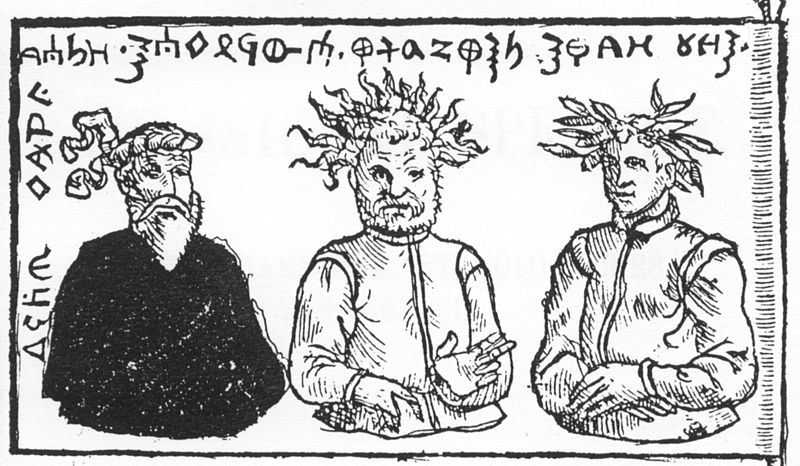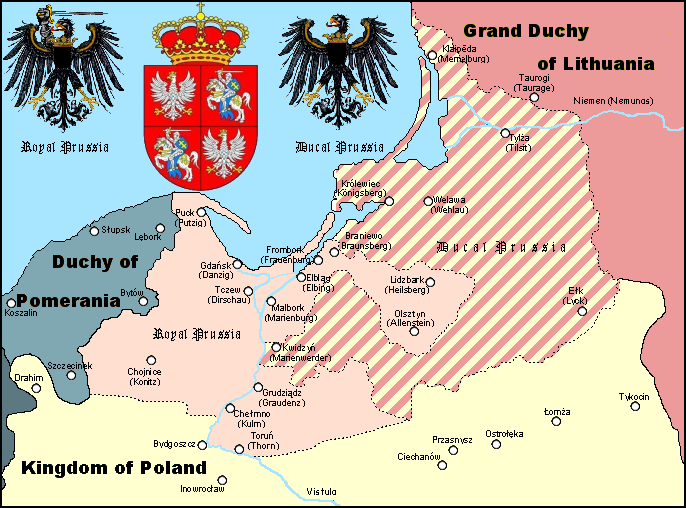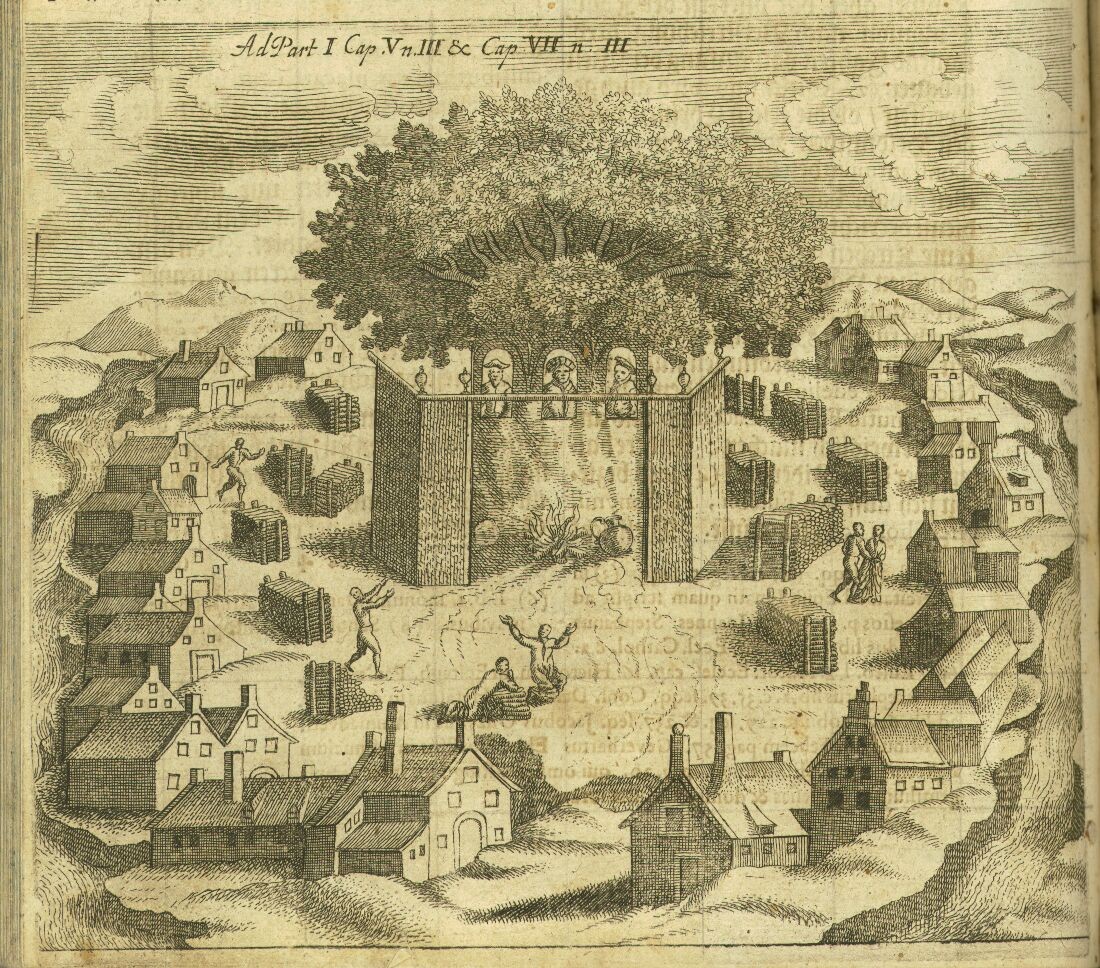|
Widewuto
Widewuto (also ''Viduutus'', ''Vidvutus'', ''Witowudi'', ''Waidewut'', ''Vaidevutis'') was a legendary king of the pagan Prussians who ruled along with his elder brother, the high priest (''Kriwe-Kriwajto'') Bruteno in the 6th century AD. They are known from writings of 16th-century chroniclers , Simon Grunau, and Lucas David. Though the legend lacks historical credibility, it became popular with medieval historians. It is unclear whether the legend was authentically Prussian (i.e. recorded from Prussian mythology) or was created by Grunau (possibly inspired by Biblical Moses and Aaron), though Lithuanian researchers tend to support its authenticity. Names Widewuto's name is found in literature in different forms: Veijdenutus, Vydevutis, Vidowuto, Viduutus, Waidewut, Wejdewut, Wenedut, Widewuto, Widewutte, Widiwutus, Wydowudo, Wydowudus, Widowuto, Wydowuto, Widowutus, Witoud, Witoudo, Witouito, Witowudus, Witowuto, Wotowudo, Vaidevutis (modern Lithuanian emendation). As for his b ... [...More Info...] [...Related Items...] OR: [Wikipedia] [Google] [Baidu] |
Patrimpas
Potrimpo (also ''Potrimpus'', ''Autrimpo'', ''Natrimpe'') was a god of seas, earth, grain, and crops in the pagan Baltic, and Prussian mythology. He was one of the three main gods worshiped by the Old Prussians. Most of what is known about this god is derived from unreliable 16th-century sources. He was first mentioned (as ''Natrimpe'') in a 1418 memorandum ''Collatio Espiscopi Varmiensis'' sent by the Bishop of Warmia to Pope Martin V. The document reminded the Pope that the Teutonic Knights successfully Christianized pagan Prussians, who previously worshipped "demons" Perkūnas, Potrimpo and Peckols (and Patollo). Simon Grunau claimed that Potrimpo was a god of grain and together with thunder god Perkūnas and death god Peckols formed a pagan trinity. He was depicted on the purported Flag of Widewuto as a young, merry man wearing a wreath of grain ears. Grunau further claimed that snakes, as creatures of Potrimpo, were worshipped and given milk (cf. žaltys). The ''Sudovian Bo ... [...More Info...] [...Related Items...] OR: [Wikipedia] [Google] [Baidu] |
Prussia (region)
Prussia (Old Prussian: ''Prūsa''; german: Preußen; lt, Prūsija; pl, Prusy; russian: Пруссия, tr=Prussiya, ''/Prussia/Borussia'') is a historical region in Europe on the south-eastern coast of the Baltic Sea, that ranges from the Vistula delta in the west to the end of the Curonian Spit in the east and extends inland as far as Masuria. Tacitus's '' Germania'' (98 AD) is the oldest known record of an eyewitness account on the territory and its inhabitants. Pliny the Elder had already confirmed that the Romans had navigated into the waters beyond the ''Cimbric peninsula'' (Jutland). Suiones, Sitones, Goths and other Germanic people had temporarily settled to the east and west of the Vistula River during the Migration Period, adjacent to the Aesti, who lived further to the east. Overview The region's inhabitants of the Middle Ages have first been called ''Bruzi'' in the brief text of the Bavarian Geographer and since been referred to as Old Prussians, who, beginnin ... [...More Info...] [...Related Items...] OR: [Wikipedia] [Google] [Baidu] |
Simon Grunau
Simon Grunau (c. 1470 – c. 1530) was the author of ''Preussische Chronik'',Full title: ''Cronika und beschreibung allerlüstlichenn, nützlichsten und waaren historien des namkundigenn landes zu Prewssen'' or ''Chronicle and description of the most amusing, useful and true known history of the Prussian land'' the first comprehensive history of Prussia. The only personal information available is what he wrote himself in his work: that he was a Dominican priest from Tolkemit (Tolkmicko) near Frauenburg (Frombork) just north of Elbing (Elbląg) in the Monastic State of the Teutonic Order. He preached in Danzig (Gdańsk) and claimed to have met Pope Leo X and Polish King Sigismund I the Old. The chronicle was written in the German language sometime between 1517 and 1529. Its 24 chapters deal with Prussian landscape, agriculture, inhabitants, their customs, and history from earliest times to up to 1525 when the Protestant Duchy of Prussia was created. It also contains a short (about a ... [...More Info...] [...Related Items...] OR: [Wikipedia] [Google] [Baidu] |
Prussian Mythology
The Prussian mythology was a polytheistic religion of the Old Prussians, indigenous peoples of Prussia before the Prussian Crusade waged by the Teutonic Knights. It was closely related to other Baltic faiths, the Lithuanian and Latvian mythologies. Its myths and legends did not survive as Prussians became Germanized and their culture extinct in the early 18th century. Fragmentary information on gods and rituals can be found in various medieval chronicles, but most of them are unreliable. No sources document pagan religion before the forced Christianization in the 13th century. Most of what is known about Prussian religion is obtained from dubious 16th-century sources (''Sudovian Book'' and Simon Grunau). Historical background and sources The Teutonic Order, a crusading military order, began the Prussian Crusade in the 1220s. Their goal was to conquer and convert pagan Prussians to Christianity. The Knights built log and stone fortresses, which proved to be impregnable to the ... [...More Info...] [...Related Items...] OR: [Wikipedia] [Google] [Baidu] |
Perkūnas
Perkūnas ( lt, Perkūnas, lv, Pērkons, Old Prussian: ''Perkūns'', ''Perkunos'', Yotvingian: ''Parkuns'', Latgalian: ''Pārkiuņs'') was the common Baltic god of thunder, and the second most important deity in the Baltic pantheon after Dievas. In both Lithuanian and Latvian mythology, he is documented as the god of sky, thunder, lightning, storms, rain, fire, war, law, order, fertility, mountains, and oak trees. Etymology The name continues PIE ''*'', cognate to ''*'', a word for "oak", " fir" or "wooded mountain". The Proto-Baltic name *''Perkūnas'' can be reconstructed with certainty. Slavic Perun is a related god, but not an etymologically precise match. Finnish Perkele, a name of Ukko, is considered a loan from Baltic. Another connection is that of ''terpikeraunos'', an epithet of Zeus meaning "''who enjoys lightning''". Perkūnas in written sources Most information about Perkūnas comes from folklore songs, legends, and fairy tales. Because most of them ... [...More Info...] [...Related Items...] OR: [Wikipedia] [Google] [Baidu] |
Peckols
Peckols and Patollo (known under a multitude of different names) were gods in the pagan Prussian mythology who were worshiped by the Old Prussians. Most researchers believe that, despite varying names, Peckols and Patollo were probably the same god in charge of the underworld and the dead. It is usually described as an angry, evil spirit similar to the Lithuanian Velnias. ''Patollu'' was first mentioned in 1418 by Bishop of Warmia in a letter to the Pope. Chronicler Simon Grunau (1529) provided more vivid but dubious details about ''Patollo''. According to Grunau, ''Patollo'' was one of the three gods portrayed on the flag and coat of arms of King Widewuto and worshiped in the temple of Rickoyoto. He was portrayed as an old man with a white beard and a white headdress similar to a turban. He was a frightening and ruthless god of the dead who would haunt and taunt the living if they disobeyed their pagan priests or buried the dead without proper sacrifices to the gods. Many oth ... [...More Info...] [...Related Items...] OR: [Wikipedia] [Google] [Baidu] |
Kriwe-Kriwajto
''Kriwe Kriwaito'' ( lv, krīvu krīvs, lt, krivių krivaitis) or simply ''Kriwe'' ( lv, krīvs, lt, krivis) was the chief priest in the Baltic mythology. Known primarily from the dubious 16th-century writings of Simon Grunau, the concept of ''kriwe'' became popular during the times of romantic nationalism. However, lack of reliable written evidence has led some researchers to question whether such pagan priest actually existed. The title was adopted by Romuva, the neo-pagan movement in Lithuania, when Jonas Trinkūnas was officially installed as ''krivių krivaitis'' in October 2002. Written sources Peter of Dusburg wrote about ''kriwe'' in his chronicle ''Chronicon terrae Prussiae'' finished in 1326. According to him, ''kriwe'' lived in Romuva and was respected as a Catholic pope not only by the Old Prussians but also by other Baltic tribes. His envoys carried a certain rod (Latin: ''baculum'') or another symbol and commanded respect both from the nobles and the paupers. ... [...More Info...] [...Related Items...] OR: [Wikipedia] [Google] [Baidu] |
Lithuania
Lithuania (; lt, Lietuva ), officially the Republic of Lithuania ( lt, Lietuvos Respublika, links=no ), is a country in the Baltic region of Europe. It is one of three Baltic states and lies on the eastern shore of the Baltic Sea. Lithuania shares land borders with Latvia to the north, Belarus to the east and south, Poland to the south, and Russia to the southwest. It has a Maritime boundary, maritime border with Sweden to the west on the Baltic Sea. Lithuania covers an area of , with a population of 2.8 million. Its capital and largest city is Vilnius; other major cities are Kaunas and Klaipėda. Lithuanians belong to the ethno-linguistic group of the Balts and speak Lithuanian language, Lithuanian, one of only a few living Baltic languages. For millennia the southeastern shores of the Baltic Sea were inhabited by various Balts, Baltic tribes. In the 1230s, Lithuanian lands were united by Mindaugas, Monarchy of Lithuania, becoming king and founding the Kingdom of Lithuania ... [...More Info...] [...Related Items...] OR: [Wikipedia] [Google] [Baidu] |
Legendary Rulers
Legendary may refer to: * Legend, a folklore genre * Legendary (hagiography) ** Anjou Legendarium * J. R. R. Tolkien's legendarium Film and television * ''Legendary'' (film), a 2010 American sports drama film * ''Legendary'', a 2013 film featuring Dolph Lundgren * ''Legendary'' (TV series), a 2020 American reality competition series * "Legendary" (''Legends of Tomorrow''), a television episode Music Albums * ''Legendary'' (AZ album), 2009 * ''Legendary'' (The Summer Set album) or the title song, 2013 * ''Legendary'' (TQ album) or the title song, 2013 * ''Legendary'' (Tyga album) or the title song, 2019 * ''Legendary'' (Z-Ro album), 2016 * ''Legendary'' (Zao album), 2003 * ''Legendary'', by Kaysha, 2006 * '' The Legendary'', an EP by the Roots, 1999 Songs * "Legendary" (Deadmau5 and Shotty Horroh song), 2017 * "Legendary" (Welshly Arms song), 2016 * "Legendary", by Alaska Thunderfuck from ''Anus'', 2015 * "Legendary", by Daya from '' Daya'', 2015 * "Legendary", by ... [...More Info...] [...Related Items...] OR: [Wikipedia] [Google] [Baidu] |
Encyclopaedia Of Religion And Ethics
An encyclopedia (American English) or encyclopædia (British English) is a reference work or compendium providing summaries of knowledge either general or special to a particular field or discipline. Encyclopedias are divided into article (publishing), articles or entries that are arranged Alphabetical order, alphabetically by article name or by thematic categories, or else are Hyperlink, hyperlinked and searchable. Encyclopedia entries are longer and more detailed than those in most dictionary, dictionaries. Generally speaking, encyclopedia articles focus on ''factual information'' concerning the subject named in the article's title; this is unlike dictionary entries, which focus on Linguistics, linguistic information about words, such as their etymology, meaning, pronunciation, use, and grammar, grammatical forms.Béjoint, Henri (2000)''Modern Lexicography'', pp. 30–31. Oxford University Press. Encyclopedias have existed for around 2,000 years and have evolved considera ... [...More Info...] [...Related Items...] OR: [Wikipedia] [Google] [Baidu] |
Ear (botany)
An ear is the grain-bearing tip part of the stem of a cereal plant, such as wheat or maize. It can also refer to "a prominent lobe in some leaves." The ear is a spike, consisting of a central stem on which tightly packed rows of flowers grow. These develop into fruits containing the edible seeds. In corn (maize), an ear is protected by leaves called husks. Inside an ear of corn is a corncob. In some species (including wheat), unripe ears contribute significantly to photosynthesis, in addition to the leaves lower down the plant. A parasite known as '' Anguina tritici'' (Ear Cockle) specifically affects the ears on wheat and rye by destroying the tissues and stems during growth. The parasite has been eradicated in most countries (with the exception of North Africa and West Asia) by using the crop rotation Crop rotation is the practice of growing a series of different types of crops in the same area across a sequence of growing seasons. It reduces reliance on one se ... [...More Info...] [...Related Items...] OR: [Wikipedia] [Google] [Baidu] |
Romuva (temple)
Romuva or Romowe (also known as Rickoyoto in the writings of Simon Grunau) was an alleged pagan worship place (a temple or a sacred area) in the western part of Sambia, one of the regions of pagan Prussia. In contemporary sources the temple is mentioned only once, by Peter von Dusburg in 1326. According to his account, Kriwe-Kriwajto, the chief priest or "pagan pope", lived at Romuva and ruled over the religion of all the Balts. According to Simon Grunau, the temple was central to Prussian mythology. Even though there are considerable doubts whether such a place actually existed, the Lithuanian neo-pagan movement '' Romuva'' borrowed its name from the temple. Historical accounts According to Peter von Dusburg, writing in 1326, the name ''Romuva'' is derived from the word Rome. He describes the Kriwe as a powerful priest who was held in high regard by the Prussians, Lithuanians, and Balts of Livonia. His messengers were recognized by a certain rod or other insignia. He guarded ... [...More Info...] [...Related Items...] OR: [Wikipedia] [Google] [Baidu] |




_-_1909.jpg)

